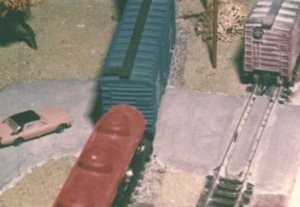If you do, or you have had one in the past, what materials, if any, did you use to cross the tracks?
I'm looking for techniques that are used for when I start on my HO layout Coyote Plains. I have built a crossing before in 'N' & I used plasticard to go between the rails, but I wasn't very happy with the result, it looked to false & really looked like painted plasticard between the rails LOL.
I was thinking of using plaster for the HO layout & then scribing out for the wheel flange.
So what do you guys use?
I'm looking for techniques that are used for when I start on my HO layout Coyote Plains. I have built a crossing before in 'N' & I used plasticard to go between the rails, but I wasn't very happy with the result, it looked to false & really looked like painted plasticard between the rails LOL.
I was thinking of using plaster for the HO layout & then scribing out for the wheel flange.
So what do you guys use?





